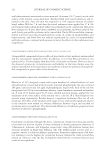DERMAL EFFECTS OF UNSAPONIFIABLE COMPOUNDS 219 37 females, the daily ingestion of 13.5 or 27 g of squalene resulted in signifi cantly de- creased facial wrinkles, but was associated with a high incidence of transient loose stool (20). TRITE RPENE ALCOHOLS Trite rpene alcohols are compounds with a general structure of six isoprene units. They exhibit several biological properties, which may be important in terms of their dermal activity: anti-infl ammatory, antitumor, chemopreventive, and antimycobacterial activi- ties (21–24). PHYTO STEROLS Phyto sterols are sterol compounds chemically similar to cholesterol, which plays a crucial role in ensuring the structural integrity of the skin’s stratum corneum (25). About 98% of all phytosterols in plants are represented by β-sitosterol, campesterol, and stigmasterol (26). β-sitosterol has been reported to possess angiogenic activity, which promoted fi bro- blast multiplication and consequently the wound healing activity (27). β-Sitosterol was also found to increase the effect of vitamin D on the immune function of macrophages (28). In general, in vitro studies showed the antioxidative, anti-infl ammatory, and antitu- mor properties of phytosterols (26,29). In a study using skin equivalents and cDNA mi- croarrays, apple seed phytosterols were shown to signifi cantly affect the regulation of genes associated with keratinocyte proliferation and differentiation, stimulate the synthe- sis of hyaluronic acid, and increase epidermal thickness (30). In addition, phytosterols were proposed for use in hair care because of their hair softening and hair conditioning properties (31). TETRATER PENOIDS: CAROTENOIDS Caroteno ids are plant pigments of the tetraterpene family, and are responsible for the yel- low, orange, or red color of plant tissues such as fl owers and fruits. Carotenoids are classi- fi ed based on their functional groups as xanthophylls, carotenes, and lycopene (32,33). Other compounds such as apocarotenoids are also derived from carotenoids by oxidative cleavage (34). Benefi cial biological effects of carotenoids mainly derive from their anti- oxidative properties, and encompass direct antioxidative effects, and photoprotective, anti-infl ammatory, antitumor, and immunostimulative effects (32,35,36). TOCOPHER OLS AND TOCOTRIENOLS (VITAMIN E) Vitamin E is a common term for the so-called tocochromanols, which are divided into tocopherols and tocotrienols, each having four forms, that is, alpha, beta, gamma, and delta (33). Vitamin E is a crucial antioxidant in the cell membranes of plants and animals, including the human skin, and in human sebum, with the most biologically active form being α-tocopherol (38). Evidence of its benefi cial dermal use due to photoprotective
JOURNAL OF COSMETIC SCIENCE 220 activity include decreased erythema, decreased tumor incidence and decreased lipid per- oxidation, and improvements in wrinkled skin (39). PHENOLIC COMPOUNDS FLAVONOID S Flavonoid s are typical representatives of phenolic compounds that are widely present in the plant world, and give yellow, red, blue and violet color to fl owers, leaves, and fruits. They were shown to have signifi cant antioxidative activity both in in vitro and in vivo systems (40–44). They also act as antibacterial (45,46), antiviral (47,48), and anti-infl am- matory agents (47,49). FERULIC A CID Ferulic a cid is widely present in plants, either freely or covalently bound to, for example, mono-, di-, and polysaccharides glycoproteins polyamines and lignin (1). Most impor- tant and well researched is its antioxidative activity, which was shown in keratinocytes, fi broblasts, and animals, as well as wound healing, photoprotective, and antimelanogenic activities (50–52). Orally administered to mice, ferulic acid improved psoriasis-like skin lesions (53). In addition, ferulic acid ameliorated symptoms of atopic dermatitis on mice skin (54). WAXES In plants , waxes cover surfaces of leaves and fruits, and restrict the loss of water, control the exchange of gases, and protect against pathogens. They typically consist of an ester- bonded long-chain (C18-22) fatty acid to a long-chain (C26-28) alcohol (6). Most known in terms of dermal application is the liquid wax of jojoba seeds also known as jojoba oil, which has been shown to accelerate the wound closure of both the keratinocytes and fi - broblasts in scratch wound experiments, and to stimulate collagen I synthesis in fi bro- blasts, whereas no effect was detected on the secretion of matrix metalloproteinase (MMP)-2 and MMP-9 gelatinases by keratinocytes or fi broblasts (55). In addition, jojoba wax was reported to express hydration, antioxidative, anti-infl ammatory, and antibacterial effects on the skin (56). GAMMA ORY ZANOL γ-Oryzanol is a mixture of esters of ferulic acid and triterpene alcohols (mainly cyclo- artenol and 24-methylencycloartenol) or sterols (mainly beta-sitosterol and campesterol), extracted from rice bran oil (1). In vitro tests confi rmed its antioxidative activity, includ- ing protection against the oxidation of vegetable oils with a high content of unsaturated fatty acids in triglycerides (57,58). A study on rats showed that intradermally injected γ-oryzanol signifi cantly inhibited dermal allergic reaction due to the inhibition of mast
Purchased for the exclusive use of nofirst nolast (unknown) From: SCC Media Library & Resource Center (library.scconline.org)

























































































































